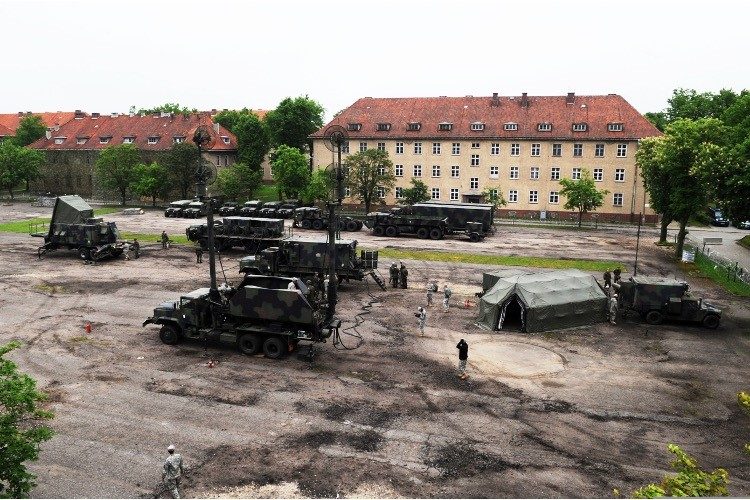
Though President Joe Biden has ruled out sending troops to defend Ukraine from Russia, yesterday the government announced it would send two Patriot missile defense batteries to Poland.
Meanwhile, the United States rejected an offer from NATO ally Poland to help transfer MiG fighters to Ukraine, a move Russia might consider as NATO entering the war.
One possible, terrifying result: Russia using nuclear weapons.
No Fighters
The decision to send the Patriot system, which can knock down incoming ballistic and cruise missiles, was announced yesterday.
“Russia has fired at least 670 missiles into Ukraine, a senior defense official said Tuesday, and there are fears that an errant missile could land in Poland, which the Patriot missile system could defend against,” the Wall Street Journal reported.
“This is a prudent force protection measure that underpins our commitment to Article Five and will in no way support any offensive operations,” the U.S. European Command announced. “Every step we take is intended to deter aggression and reassure our allies.”
Article Five says an attack on one NATO member “shall be considered an attack against them all and consequently they agree that, if such an armed attack occurs, each of them, in exercise of the right of individual or collective self-defense recognized by Article 51 of the Charter of the United Nations, will assist the Party or Parties so attacked by taking forthwith, individually and in concert with the other Parties, such action as it deems necessary, including the use of armed force, to restore and maintain the security of the North Atlantic area.”
The Pentagon quickly rejected Poland’s offer “to deploy — immediately and free of charge — all their MIG-29 jets to the Ramstein Air Base and place them at the disposal of the Government of the United States of America.”
Poland also asked other NATO allies to release their MiGS, and for the United States to provide replacements for the jets it send to Ramstein.
Biden shot down the proposal.
“The prospect of fighter jets ‘at the disposal of the Government of the United States of America’ departing from a U.S./NATO base in Germany to fly into airspace that is contested with Russia over Ukraine raises serious concerns for the entire NATO alliance,” Pentagon spokesman John Kirby said:
It is simply not clear to us that there is a substantive rationale for it. We will continue to consult with Poland and our other NATO allies about this issue and the difficult logistical challenges it presents, but we do not believe Poland’s proposal is a tenable one.
Poland offered the jets after Secretary of State Antony Blinken, appearing on CBS’s Face the Nation, said Poland and NATO can supply Ukraine with fighters:
That gets a green-light. We’re talking with our Polish friends right now about what we might be able to do to backfill their needs if in fact they choose to provide these fighter jets to the Ukrainians. What can we do? How can we help to make sure that they get something to backfill the planes that they are handing over to the Ukrainians?
How Russia would respond is the question.
Last week, Russia’s Defense Ministry warned that countries who offer airfields to deploy “military aircraft and their subsequent use against the Russian armed forces may be regarded as the involvement of these states in an armed conflict.”
What might it think if and when NATO provides fighters?
Nuclear War Ahead?
The answer to that question is likely the reason Biden rejected Poland’s offers to move MiGs to Germany.
“The world should take Russia’s escalating nuclear threats very seriously, senior intelligence officials told lawmakers Tuesday, while noting that they have not yet seen clear indications that Russian leader Vladimir Putin would respond to military setbacks in Ukraine with nukes,” Patrick Tucker reported for Defense One yesterday:
Putin sparked alarm among nuclear watchers last month when he ordered the country’s nuclear forces be put on a “special regime of combat duty.” Speaking to lawmakers on Tuesday, Avril Haines, the director of Office of the Director for National Intelligence, said that move was mostly “signaling” to keep NATO from intervening in Ukraine.
“He is effectively signaling that he’s attempting to deter and that he has done that in other ways. For example, having the strategic nuclear forces exercise that we indicated had been postponed until February, again, then as a method of effectively deterring,” Haines said.
Other officials agreed, and a former defense official explained how Russia might use its nukes. “Russia has nuclear weapons as part of a warfighting battle plan,” the official said:
The danger is increasing “precisely because the conflict in Ukraine is going badly.”
The official outlined a scenario in which Putin consolidates some gains in southern Ukraine but fails to install a new puppet regime.
“Ukrainians may or may not cease and desist. The West may or may not continue to arm the Ukrainian insurgency and [Putin] might decide, ‘OK. I’m going to set off a bomb somewhere in western Ukraine to send a message that I have crossed the nuclear threshold, and you can follow me if you want.’”
Putin likely thinks NATO threatens Russia because the treaty organization expanded so aggressively after the Soviet Union collapsed. Since 1999, 14 countries have joined. Membership now is 30 nations.
In 1997, Biden himself warned that Russia would view that expansion into the Baltic states as a threat.


